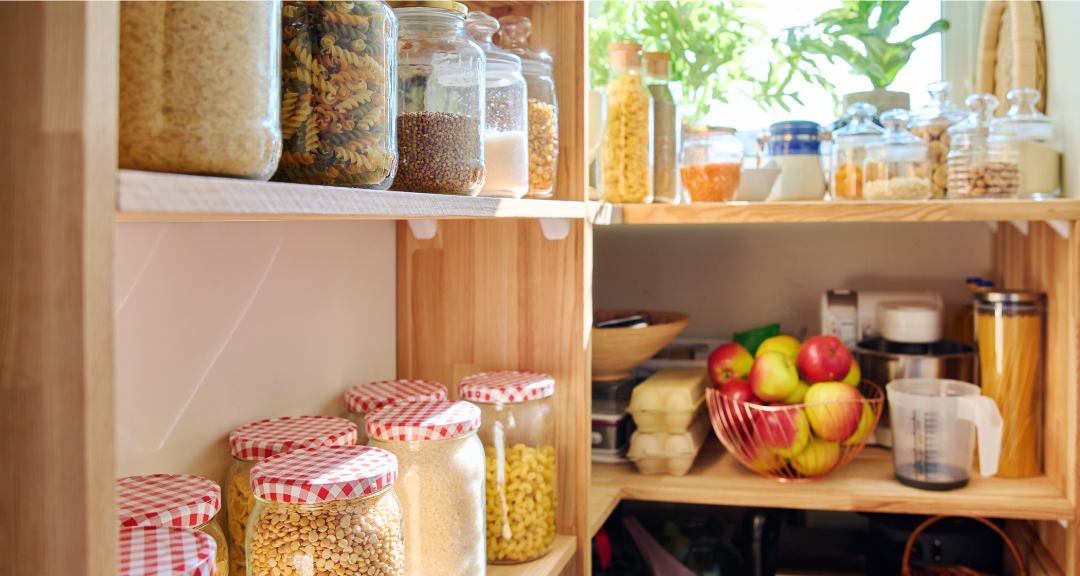Have you ever found yourself with a cabinet full of cans of diced tomatoes or garbanzo beans, only to realize that you’ve been buying duplicates of the same items? In the past, my child would remind me that we have many of one item in the cupboard as we put the groceries away.
Fortunately, with a few simple strategies, you can streamline your pantry, prevent duplicate buys, and even save money. Here’s how to organize your pantry to avoid buying duplicates.
Table of Contents
- 1. Start with a Clean Slate
- 2. Categorize and Subcategorize
- 3. Use Clear Containers and Labels
- 4. Create an Inventory System
- 5. Implement a First-In, First-Out System
- 6. Designate Zones for Different Categories
- 7. Regularly Review and Adjust
- 8. Use a Meal Planning Strategy
- 9. Communicate with Household Members
- In closing
1. Start with a Clean Slate
Before diving into organizational tactics, clear out your pantry. Remove everything from the shelves and group items by category—canned goods, grains, spices, snacks, etc. This step will help you see what you already have and identify any duplicates. Check expiration dates and discard anything that’s expired or no longer usable. I find this is a good task to do 1-2 times a year.

2. Categorize and Subcategorize
Once you’ve decluttered, categorize your items to make them easier to track. Here’s a suggested approach:
- Staples: Flour, sugar, rice, pasta
- Canned Goods: Beans, tomatoes, soups
- Spices and Condiments: Salt, pepper, olive oil, ketchup
- Snacks: Chips, nuts, granola bars
Within these categories, subcategorize if necessary. For example, group canned vegetables separately from canned fruits. This system will help you quickly see what you have and what you need.
3. Use Clear Containers and Labels
Invest in clear, airtight glass containers for pantry staples like flour, sugar, and pasta. Not only do these containers keep your food fresh, but they also make it easier to see when you’re running low. By using a glass container, you use a permanent marker to label each container directly on the surface with its contents and expiration date (use isopropyl alcohol to remove the marker when needed). For spices and smaller items, consider using a wall spice rack to keep them organized and easy to find.
4. Create an Inventory System
Maintaining a pantry inventory can help you track what you have and prevent duplicates. There are a few ways to keep an inventory:
- Digital Apps: Use pantry management apps like Pantry Check, Sortly, or Cozi to keep track of your items. These apps often allow you to scan barcodes and set reminders for when you’re running low.
- Manual Lists: Maintain a written list or spreadsheet of your pantry items. Update it regularly as you add or use up items.
5. Implement a First-In, First-Out System
To prevent food from going to waste and ensure that older items are used first, implement a “first-in, first-out” system. Place newer items behind older ones, so you use up the older stock first. This practice helps minimize waste and avoids buying duplicates of items you already have. This step works best if you have a large pantry and/or stock many of the same ingredient at one time.
Mind Reader 6 Compartment Upright Breakroom Coffee Condiment and Cup Storage Organizer, Black
$16.49 (as of October 15, 2024 01:15 GMT -07:00 – More infoProduct prices and availability are accurate as of the date/time indicated and are subject to change. Any price and availability information displayed on [relevant Amazon Site(s), as applicable] at the time of purchase will apply to the purchase of this product.)6. Designate Zones for Different Categories
Organize your pantry so that similar items are grouped together. For example, keep all canned goods on one shelf, baking supplies on another, and snacks in a separate area. This zoning helps you quickly locate items and avoid buying more of what you already have.
7. Regularly Review and Adjust
Periodically review your pantry organization to ensure it still meets your needs. As your cooking habits or family size changes, you may need to adjust your categories or inventory system. Regular checks will help you stay on top of what you have and what you need.
8. Use a Meal Planning Strategy
Integrate your pantry organization with meal planning. Plan your meals for the week based on what you already have in your pantry. This approach not only helps you avoid duplicates but also ensures that you’re using up items before they expire.
9. Communicate with Household Members
If you live with others, make sure everyone is aware of the pantry organization system. Establish a routine for updating the inventory when items are added or removed. Clear communication helps prevent duplicate purchases and keeps the pantry organized.
In closing
Organizing your pantry to avoid buying duplicates is not just about tidying up; it’s about creating a system that works for you and your household. By decluttering, categorizing, labeling, and maintaining an inventory, you can keep track of what you have, make informed shopping decisions, and reduce food waste. With a well-organized pantry, you’ll save time, money, and avoid the frustration of discovering duplicate items. So roll up your sleeves, get organized, and enjoy the benefits of a more efficient and effective pantry!

